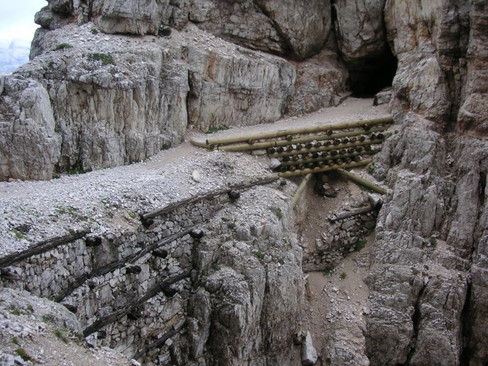History of Via Ferrata
- outver

- Dec 27, 2023
- 7 min read
Equipped routes known by the italian name Via Ferrata or the german term Klettersteig are becoming an increasingly popular alternative between mountain hiking and climbing. Today's sport entertainment has its roots in the securing of passage through dangerous mountain terrain.

Securing pathways with ladders or ropes has been used since ancient times to simplify travel between mountain villages and homesteads. Back then, wooden steps or railings, or hemp ropes, were used. The iron elements that later gave the sport its name were still in their infancy.
The first secured routes for tourists began to emerge in the nineteenth century. Earlier, artificial aids such as ladders, stakes, and footholds were used to facilitate ascents to mountain peaks. However, at that time, these were not stably secured paths yet.
Reportedly, the very first secured route was established in 1492 to the summit of Mont Aiguille (2085 m) in the French region of Dauphiné. This was at the request of the French king Charles VIII. Lladders and ropes were installed for the ascent of the wall to the summit. Three crosses were erected at the top, and for several centuries, no one repeated this ascent.
Pre-War beginnings of sport ferratas
The first truly sport Via Ferrata, or rather Klettersteig, was created long before World War I. In 1843. Steel rings and stakes were used to secure the ascent to Hoher Dachstein. Its author was Friedrich Simony, born in 1813 in Hrochov Tynec near Chrudim in Czechia. Originally a pharmacist, he studied natural sciences at the University of Vienna. In 1840, he embarked on research expeditions to the Alps, specifically the region of the Salzkammergut. He first climbed the summit of Dachstein (2995 m) in the autumn of 1842, ten years after the first ascent by Peter Gappmayr. Simony decided to make this challenging ascent accessible to other tourists.
During the following summer, together with the Hallstatt guide Johann Wallner, they installed iron securing elements and built footholds to the summit. In September 1843, Simony became the first person to spend the night at the top. Due to meteorological observations, he spent four nights there. Later, he achieved the first winter ascent and many other mountain feats. In 1862, he co-founded the Austrian Alpine Club (Österreichischer Alpenverein), which now owns a hut bearing his name. This hut was built in 1876-1877 at the foot of Dachstein at an altitude of 2205 meters, replacing the original emergency shelter called Hotel Simony.
In the 19th century, several other secured routes were created. A ferrata on the southwest ridge led to the highest mountain in Austria, Grossglockner (3798 m). Another Czech native, Johann Stüdl (1839-1925), played a key role. Born in Prague, he studied chemistry in Dresden. He was one of the most important pioneers in the Grossglockner region, co-founder of the German Alpine Club (1862), and contributed to the establishment of organized mountain rescue (1882). Thanks to the Prague section of the club, where he served for many years, many famous mountain huts were built. To this day, we know Alte Prager Hüte and Neue Prager Hüte, Olpererhüte, Stüdlhütte bearing his name, or Payerhütte named after a native of Teplice, an alpinism pioneer and polar explorer.
The secured route along the ridge, known as Stüdlgrat, did not survive due to harsh climatic conditions. Thomas, Rupert, and Michel Groder worked for over two months on the stretched four-hundred-meter ropes and other supporting elements.

In 1873, the ascent to the highest mountain in Germany, Zugspitze, was secured. Other routes for tourist exploration were also created in Italy, especially in the eastern walls of the Brenta, where short secured sections began to appear from 1880. The main contributors were mountain guides from Madonna di Campiglio.
In the Pyrenees, the first artificial securing elements were installed on Pic du Midi d'Ossau in 1880 and in Ordesa a year later.
In the Northern Limestone Alps, the first routes were built at the turn of the century, which are still in use today. An example is Heilbronner Weg in the German Algavské Alp (1899), followed by Eggersteig (1903) and Wildauersteig (1911) in the Wilder Kaiser range in Austria.
In the Dolomites, the ascent to Marmolada was secured in 1903 via the western ridge, and before World War I, the Possnecker Klettersteig on Piz Selva in the Sella group was completed.
In 1910, Gustav Jahn and August Čepl, a Vienna locksmith, built Hans von Haid Steig on Preiner Wall (1783 m) in the eastern Rax.

First World War
The development of tourism and mountain sports was temporarily halted by World War I (1914-18). In 1914, the Dolomites were part of Austria-Hungary, which was part of the Central Powers during the war.
The war front in the Dolomites led through demanding and dangerous terrain at high altitudes. Italian and Austrian soldiers, while guarding borders and fighting for high mountain positions, simplified movement in rocky terrain with artificial elements.
During that time, a large number of secured routes were created, which have, in their traditional lines, survived to this day for sporting purposes. Soldiers installed ladders and fixed ropes into the rocks, which are now replaced by new and certified steel elements. In many places in the Dolomites, however, traces of the original war paths can still be seen.
Soldiers used secured routes to access and transport materials to strategically positioned locations. Rocky peaks served as observation points and as positions for heavy artillery brought there. Tunnels were often dug into the rocks so that soldiers could move and not be seen by the enemy. An entire town was built in the Marmolada glacier. Other tunnels served as offensive tunnels, boring under the enemy's positions and attacking with explosives.
Most relics of the cruel trench warfare can be found, for example, on Monte Piana, around Lagazuoi, or on the opposite Hexenstein. The Giovanni Lipella ferrata is also well-known, with a several hundred-meter section ascending through a preserved war tunnel on the Tovany di Roses slope.
After the war, the abandoned routes were taken over by the Italian Alpine Club, whose members repaired the original paths and built new ones. Wooden elements were replaced by steel, as were hemp ropes.
Project Brenta
In the 1930s, members of the Italian Alpine Club (CAI - Club Alpino Italiano), together with SAT (Societa Alpinistica Trentina), contributed to facilitating access to climbing routes in the Brenta range. They installed artificial securing aids and ropes, connecting natural lines and paths in the rocks. The development of the system of secured routes continued after World War II, and the well-known Via delle Bocchette was created. Crossing the Brenta massif became a popular challenge for climbers and high-altitude tourists. The route is considered classic, with a minimum of artificial securing aids. Most peaks are still accessible only by rock climbing.
Modern routes
With the tourist boom in the 1970s, many war routes were restored, and the construction of new ferratas expanded to other parts of the Alps. The routes were mostly built by the climbing community, often with the active involvement of one of the relevant alpine clubs (although occasional disputes over the purity of mountaineering and resistance to some added routes were already emerging).
On the Italy-Austria border in South Tyrol, the restoration of war routes was spearheaded, for example, by Vienna native Walthera Schaumann, then a retired lieutenant colonel. At his initiative, the construction of the Filmoor-Standschützenhütte hut in the Karnische Alps began in 1976.
Ferratas became a popular sporting activity, and their proliferation increased. The first Via Ferrata in France was built in 1988 (Via Ferrata de la Grande Falaise, Freissinières, C/D). New Via Ferratas are constantly being created, often with a more modern approach. More artificial elements are used, and previously inaccessible places are made accessible.
Modern times have brought routes with a more "sporting" approach, often with shorter approaches, in more exposed terrain, and with technical sections using a large number of securing elements. Attractive places such as canyons or the vicinity of waterfalls are selected. Cable bridges are built in the terrain, and in some places, even zip-lines are added. Today, it is estimated that there are around 1000 secured routes in the Alps. In Austria, the most commonly used Schall scale A-B-C-D-E has been expanded to include grades F and G.
Ferratas are no longer built only by alpine clubs but also by local sports organizations, travel companies, and cable car operators. The proximity of an attractive secured route increases visitation and thus the use of offered services. Shorter routes are complemented by variations of various difficulties, and around huts, areas are created. Ferratas are now designed for families with children. The installed securing, length of routes, and, of course, entertaining elements along the way are adapted to this, and the distance from the parking lot is minimal.
Via Ferratas have become a separate discipline. There are several rating systems for routes, and descriptions are available in both book and digital form. Compared to traditional mountaineering, ferratas do not require as much equipment, making them accessible to a wider audience. However, due to social media and sometimes the neglect of the fact that this activity remains movement in mountain terrain and requires experience, fitness, and knowledge of the equipment used
"Ferratas" in the Czech Republic
Since the late 1990s, several clubs and associations specializing in ferratas have existed in the Czech Republic, and they mainly travel to the Alps, most often to nearby Austria.
A few short ferratas could be found just beyond the border in the Lusatian Mountains. Two of the most well-known are located near the rock castle Oybin: "Zadrátovaná Jeptiška" - Nonnensteig (C/D) and the nearby Alpiner Grat (C), which were the closest to the Alps.
In the Czech Republic, the first ferratas began to be built after 2010. Today, there are over 40 secured routes of various difficulties. A significant contribution to them has been made by climber Karel Bělina. He gained experience in ferrata construction, among other places, in Austria, where he helped with the repair and renewal of challenging ferratas in the Lienz Dolomites, such as Laserzklettersteig, Seekofelklettersteig, and others.
Bělina has built dozens of secured routes in the Czech Republic, which he hands over to the area administrator. His largest ferrata project is the Pastýřská stěna (Shepherd's Wall) in Děčín. In the second half of 2012, a total of 16 routes, up to difficulty D, were gradually built on this wall above the river, opposite Děčín Castle. The ferrata area, complemented by a rental shop and restaurant, is among the most visited in the country. Its advantage is easy accessibility (by car or train) and the option to leave personal belongings in lockers under the wall.
Additional ferratas are still being created. Due to the conditions of the Czech basin, they are not high-altitude ascents but rather shorter training routes. The difficulty depends on the course of the steel rope in the terrain and the intensity of using iron elements. Other examples include the via ferrata in Bechyně, at the Vír Dam, on Slánská hora, or near Český Krumlov.
There are plenty of options for getting acquainted with the nature of movement and safety principles, all accessible within a few hours.

























Komentari